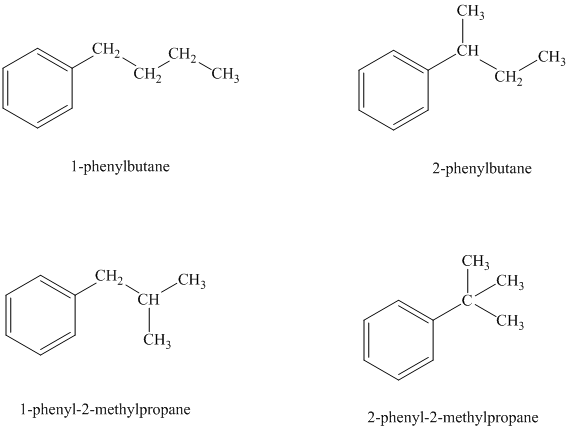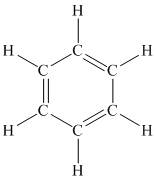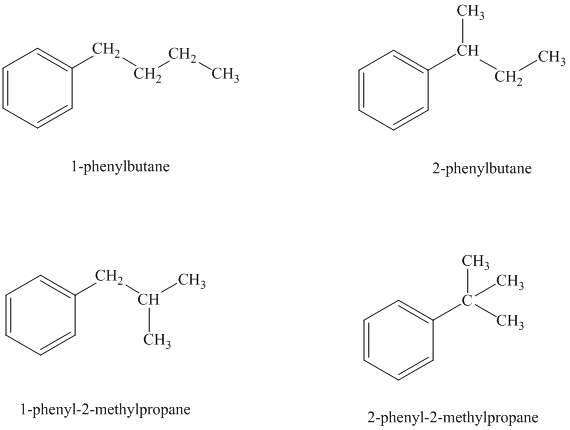
Concept explainers
Write structural formulas and give the IUPAC names for all the isomers of
Interpretation:
The structural formulas and IUPAC names for all the isomers of
Concept introduction:
A benzene ring is a cyclic six membered ring containing single and double bonds alternately between carbon atoms. One hydrogen atom is attached to each carbon atom.
In a mono substituted benzene ring, one hydrogen atom is replaced by a substituent.
The substituent should be such that each carbon atom must have formed four bonds and other atoms, if any, should have complete octets.
Answer to Problem 33P
Solution:

Explanation of Solution
The structure of a benzene ring is as follows:

One hydrogen atom is replaced by the group
There are four possible ways in which this group can be attached to the ring.
The structures and IUPAC names of the isomers are shown below:

In a mono substituted benzene ring, one hydrogen atom is substituted by a substituent. An alkyl substituent can be arranged such that each carbon atom must have formed four bonds and other atoms if any should have complete octets.
Want to see more full solutions like this?
Chapter 12 Solutions
ORGANIC CHEMISTRY-PACKAGE >CUSTOM<
- What is the difference in bonding and in general molecular formula between an alkene and a cycloalkane with the same number of carbon atoms?arrow_forwardGive the structure of the following compounds and write their IUPAC names: Ethyl propyl ether Methyl n-butyl ether Ethyl isopropyl ether Dipropyl etherarrow_forwardWrite structural formulas for three ketones that have the formula C5H10O.arrow_forward
- Ethers show functional group isomerism with * Aldehydes Ketones Alcohols Carboxylic acidsarrow_forwardWhat is the structure of a compound with the formula C7H14O that has an ether and cyclobutane ring, including its IUPAC name? In addition, what is the structure of the compound with the formula C7H14O that does NOT contain the functional groups: epoxide, ether, cycloalkane, alcohol, alkene. Indicate the functional groups used that are present in the structure made for this compound.arrow_forwardGive the reagent and the reaction conditions that would distinguish between the following compounds. Explain the principles behind the reactions. Write the chemical equation for the reactions involved. 1-chloro-3-methylbutane and 2-cyclopentenolarrow_forward
- Give the structural formula (condensed or skeletal) of the given IUPAC names of saturated hydrocarbons. 1) 2-methyl-3-oxohept-4-enoic acid 2) 4-chloro-2-oxohexanoyl chloride 3) 4-nitro-4-propoxybut-1-ene 4) 1-hydroxyhex-5-yn-2-one 5) 1-methylpropyl 3-amino-3-(1-methylpropoxy)propanoate 6) 1-ethoxy-3-mercaptohexane-2-thionearrow_forwardWrite a series of equations to illustrate each of the following reactions: 1) a substitution reaction of propane 2) a halogenation reaction of benzenearrow_forwarddraw structural formulas for all isomeric alkanes with molecular formula C7H16. Predict which isomer has the lowest boiling point and which has the highest boiling point.arrow_forward
- 3) Give the structural formulas and the old and new IUPAC names of all eight open-chain isomeric alcohols with the molecular formula CSH11OH. Indicate which of these isomers are primary, secondary, or tertiary alcohol. 4) Six isomeric saturated ethers have the molecular formula CsH120. Write the structural formula and name for each of these ethers.arrow_forward2) Draw the condensed structural formulas and write the IUPAC names for four structural isomers of the esters that have the molecular formula C5H10O2arrow_forwardFollowing is structural formula and common name for four molecules that contain both a carbon-carbon double bond and another functional group. Give an IUPAC namearrow_forward
 Organic And Biological ChemistryChemistryISBN:9781305081079Author:STOKER, H. Stephen (howard Stephen)Publisher:Cengage Learning,
Organic And Biological ChemistryChemistryISBN:9781305081079Author:STOKER, H. Stephen (howard Stephen)Publisher:Cengage Learning, World of Chemistry, 3rd editionChemistryISBN:9781133109655Author:Steven S. Zumdahl, Susan L. Zumdahl, Donald J. DeCostePublisher:Brooks / Cole / Cengage Learning
World of Chemistry, 3rd editionChemistryISBN:9781133109655Author:Steven S. Zumdahl, Susan L. Zumdahl, Donald J. DeCostePublisher:Brooks / Cole / Cengage Learning General, Organic, and Biological ChemistryChemistryISBN:9781285853918Author:H. Stephen StokerPublisher:Cengage Learning
General, Organic, and Biological ChemistryChemistryISBN:9781285853918Author:H. Stephen StokerPublisher:Cengage Learning Chemistry: Principles and PracticeChemistryISBN:9780534420123Author:Daniel L. Reger, Scott R. Goode, David W. Ball, Edward MercerPublisher:Cengage Learning
Chemistry: Principles and PracticeChemistryISBN:9780534420123Author:Daniel L. Reger, Scott R. Goode, David W. Ball, Edward MercerPublisher:Cengage Learning Chemistry: Principles and ReactionsChemistryISBN:9781305079373Author:William L. Masterton, Cecile N. HurleyPublisher:Cengage Learning
Chemistry: Principles and ReactionsChemistryISBN:9781305079373Author:William L. Masterton, Cecile N. HurleyPublisher:Cengage Learning Introductory Chemistry: An Active Learning Approa...ChemistryISBN:9781305079250Author:Mark S. Cracolice, Ed PetersPublisher:Cengage Learning
Introductory Chemistry: An Active Learning Approa...ChemistryISBN:9781305079250Author:Mark S. Cracolice, Ed PetersPublisher:Cengage Learning





